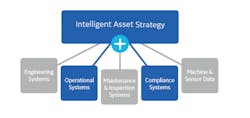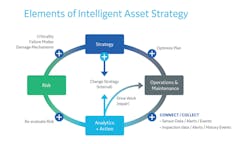Market volatility and regulations are driving a digital arms race in the oil and gas and chemical manufacturing markets. Sub $60-per-barrel oil prices are the new normal and, to drive growth, energy customers need to boost productivity, reduce risk and meet their regulatory requirements all while keeping their teams and communities safe. And, they must do all this within a much tighter cost profile than they’ve historically enjoyed.
Even with the advent of digital, offshore platforms on average experience 27 downtime days per year equating to $34 million in losses per annum. Based on 2019 global refining margins, one day of unscheduled downtime would cost a 200-barrel-per-day refinery $1.8 million in production loss alone, not including the additional of repair and labor costs.
In 2019, Marsh, a process industry insurance brokerage and risk management firm, produced a study showing a strong correlation between oil price and major loss events — with spikes in major loss events occurring in the years following significant reductions in the oil price. Similarly, a Lloyd’s Market Association study stated that “mechanical integrity failure” was responsible for 57% of those losses that were considered man-made (non-natural disaster event).
These events can be prevented.
Companies must leverage digital solutions to better understand their risk profile and where cost optimization can occur safely to maintain a competitive advantage. This is only possible by incorporating software into your core operational work processes to better integrate and automate activities across the business. Technology can help you build a foundation to achieve operational excellence.
To date, almost every enterprise has invested heavily in their assets, processes and systems on a massive scale to meet business objectives and manage risk around safety, financial and environmental events. At the scale of a global company, hundreds of thousands of assets produce enormous amounts of data every day — all with their own specific purpose. Data from sensors, recommendations from experienced workers in the company and information from a multitude of systems produce a relentless stream of asset data that can either keep you informed to help make smarter decisions or leave you vulnerable to blind spots and risk.
Because of this challenge many organizations are turning to asset performance management (APM) solutions to help them contextualize data and insights within core operational work processes within their organization. APM software creates holistic and real-time views of how people, systems and physical assets are performing. This level of visibility enables tracking of both leading and lagging key performance indicators (KPIs) around safety critical system performance, regulatory compliance, maintenance spend and effectiveness, all in the context of improving production efficiency and productivity.
An APM answers essential questions that you and your teams should be asking yourselves each day:
- How critical is this asset to our business?
- In what ways could this asset fail? How could I mitigate risk of failure? And, what would that cost?
- What is the history of this asset, and what is its current health?
- What action should be taken now, and what should be our overall strategy to optimize business objectives?
By combining real-time data with human experience, operating parameters, a risk registry and analytics, asset performance management provides a system aligned to your work processes that helps you improve over time. It’s an automated loop of learning that can detect emerging threats for prevention and proper governance.
Improve all aspects of your company
Your asset performance management initiative must focus on these three areas:
People
Your people are a wealth of knowledge and experience. Can you leverage their collective knowledge to contextualize information from physical assets and systems? Can this knowledge be embedded in the asset performance management software to leverage that knowledge at scale?
The way companies collect and manage information has evolved over time. Early on, observers in the field collected information on clipboards before entering it into historians. They relied upon experience to decide whether the data was worth recording. Today, we depend on technology and sensors to do most of that recording with a far greater degree of accuracy. However, a sensor cannot replace the critical thinking and judgment that only comes from an experienced employee. Unfortunately, due to an aging workforce and employee turnover, their knowledge and experience is often lost forever.
APM software allows you to capture the expertise and perspectives of your team by recording human recommendations and policies. Recommendations contribute to an overall strategy that provides a better understanding of the big picture within the plant. Recommendations are continuously collected based on employees’ assessment of operating parameters, analytics and activities performed in an APM. Policies allow employees to define data inputs, apply logic and calculations, and automate a decision process that historically an employee would make by themselves in the field. In this way, the information an employee contributes stays with the company long after separation, providing a seamless library of tribal knowledge and technical expertise that is passed along to the next generation.
Assets
Most organizations have invested heavily in their operations by adding sensors and monitoring critical assets which produce millions of bits of data from various systems and sources. Does that information help you or put you at greater risk?
In many cases, the addition of sensors has facilitated a step change in reliability and proactive work. As the technology has become more affordable and the amount of equipment with online data has increased, we see organizations starting to develop alert/alarm fatigue as this data is manually being analyzed, prioritized and diagnosed by individuals in the organization.
With the advent of machine learning and Digital Twins — a key component of an APM — much of the manual work has been taken out of the equation with the concept of “digital twin blueprints.” These are pre-configured models that consider how equipment fails, which sensors are available, historical performance of the asset and machine learning models. These models look across the sensor data coming from an asset or system and pre-emptively provide an engineer or analyst with not just an alert of degradation, but a diagnosis and a priority for which preventative actions need to be taken on the equipment. This is all being done days and weeks prior to alarm thresholds being reached.
Systems and processes
It takes a mixture of unique and complex systems, as well as work processes, to keep facilities and plants running. How can you aggregate the data they produce to see the big picture? Just because you have different systems doesn’t mean they can’t support a common purpose.
Although some of these systems work well together, each system is typically dedicated to performing a specific task. They could, however, work more productively and more efficiently. When the data from multiple systems comes together within an APM, the data can be combined with human experience and physical asset data to provide a holistic view. The work being recommended then becomes strategic and focused. Plus, the insight gained can be used to optimize the very systems that are providing the data.
To get more from your systems, you need to use and direct data from multiple sources to serve a common asset strategy and have a heterogeneous platform for data and analysis. Only an APM can bring data from various systems together into a single context to identify and understand the risk, enabling you to quickly drive actions to prevent failures, mitigate risks, increase asset availability and optimize costs.
An APM integrated into your core work processes at the plant and corporate level can provide benefits in these core areas:
A 2-6% increase in availability
A 10-40% reduction in reactive maintenance
A 10-20% long-term Health, Safety & Environment (HSE) incident cost reduction
This approach creates a complete, holistic and real-time view of how people, systems and physical assets perform while measuring the impact they have on your business.
An APM delivers data in context of your core operational work processes to develop new recommendations and suggested actions that can be evaluated and deployed.
Physical assets, sensors, people, work streams and systems all contribute data, readings and recommendations in real-time through a centrally managed asset strategy based on business and program objectives.
The asset strategy serves to filter, evaluate and categorize readings and recommendations. Recommendations that do not adhere to business and program objectives are filtered and set aside, providing continuous optimization.
Digital Twins can be incorporated as components of the asset strategy to provide strategic diagnostics and suggested actions that can be evaluated and deployed.
Once strategies are deployed to improve processes, systems and the overall APM, additional data feeds back into the same asset strategy to create a continuous improvement loop
Different views of asset data provide 360° view of performance
Different views of asset data mean you are always one step ahead, allowing you to assess key business risks and determine which assets should be the primary focus. So, in your planning, you should consider:
A Transaction View providing deep insight into difficult-to-reach data in your enterprise asset management systems like EAM or CMMS.
A Strategy View to gain perspective from your asset management system while combining data from other data sources.
A Trend View that feeds data from monitoring and process historian applications to convert information into insight — this can also be leveraged by the digital twin models.
A Control View to understand operating conditions that impact assets.
A Geographic View to pull key engineering data to display data within an APM with geospatial context.
A Regulatory View to configure your work processes to assure compliance with local regulations and global standards.
Most of your business risk will reside within a subset of your total asset base. Quantifying the risk an asset presents to business and focusing asset management efforts accordingly allows you to ensure that assets with significant consequences for failure scenarios or those assets subject to legal and statutory requirements have a complete and optimized management strategy.
How do you get started?
Set a clear path of what you want your organization to achieve — there is a lot of technology in the market, but you must first understand the end goal. Provide sponsorship so that teams are empowered to provide standardization across sites so that operational efficiencies can be realized.
Lastly, pilots are a powerful tool, but they must have clear requirements and defined time limits, so that whether they are a success or a failure you can move forward with operationalizing the result at scale or moving toward a different solution.
It’s time to put your industrial data to work and listen to what it has to say by building a technology foundation to achieve operational excellence.
Jared Hartness is a Senior Industry Marketing Leader for Oil and Gas with GE Digital, working with GE’s Asset Performance Management suite of solutions. Prior to joining GE Digital, Hartness began his career with Meridium serving in a number of different capacities ranging from product marketing, marketing programs and digital marketing for their Asset Performance Management software solutions. He earned a Bachelor of Science Degree in Communication and Media Studies from Radford University.



